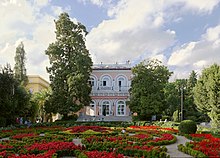Villa Angiolina
The Villa Angiolina is a historic mansion in the Croatian town of Opatija (also: Sankt Jakobi, Abbazia). With its associated park, the villa formed the starting point for the tourist development of the place.
history
The builder was Iginio Scarpa (1794–1866), a wealthy timber and wheat merchant, patrician of the then Fiume and a freemason. At the beginning of the 1840s he bought the property for his late Biedermeier Villa Angiolina, built in 1844 or 1845 for only 700 guilders (named after Scarpas, who died in 1832 at the age of 30, a née Sartori). The architect of the building is unknown. Scarpa received numerous guests in his villa, including the travel writer Heinrich Noë (1835–1896), the upper class of Fiume and in 1850 even the Croatian governor Ban Josip Jelačić and his wife. Iginio's son Paolo Scarpa married Maria von Bruck in 1855, the daughter of Karl Ludwig von Bruck , who was Austrian Finance Minister from 1855–60. The Villa Angiolina became a fashionable center of the region thanks to its wealthy owners with excellent social connections. The Scarpas held glittering parties with fireworks here. So, initially on the basis of free hospitality, the basis for the later tourist development was laid.
By the way, Paolo Scarpa propagated the idea of building a sanatorium as early as 1869 and advocated a tourism development concept. But he lacked capital. After a business failure, he even had to sell the country house to the Moravian nobleman Viktor von Chorinsky in 1875. In 1882 it was bought by the Südbahngesellschaft , which converted it into a luxury guesthouse and hosted the Crown Prince couple Rudolf and Stephanie as guests. The International Sleeping Car Company ( Compagnie Internationale des Wagons-Lits ) belonged to the later owners .
A restoration carried out in 2001 brought the large salon back to its original shape before the renovations in 1886.
use
Today the Villa Angiolina is used for museum purposes. In the front part of the ground floor, the large salon, the Croatian Museum of Tourism ( Hrvatski Muzej Turizma ) presents changing exhibitions.
In the back of the ground floor is the restored original “Madonna del Mare” by Johann Rathausky , which commemorates the boat accident on Good Friday 1891, on which the 24-year-old Arthur Kesselstatt and the 40-year-old Anna Fries were killed. The original created by Johann Rathausky stood until 1951 in the place where the "Girl with the Seagull" is now. Then the Madonna, who had been badly affected by the sea, was brought to Villa Angiolina.
A permanent exhibition on the development of the railway network and the tourism it has stimulated can be viewed on the upper floor.
park
The 3.64 hectare park is the central city park of Opatija. It was designed around the villa by Iginio Scarpa, a great nature lover, between 1845 and 1860 and enriched with numerous exotic plants such as magnolias, Lebanon cedars, Himalayan cypresses or the Japanese camellia ( Camelia japonica ), which has become a landmark for Abbazia . When the park came into the ownership of the Südbahngesellschaft in 1882, the director of the Austro-Hungarian horticultural company was entrusted with its maintenance and expansion.
The neighboring St. Jacob's Park takes its name from the oldest building in Opatija, the Church of St. Jacob ( Sv. Jakov ), which was first mentioned in a historical document from 1449.
literature
- Carl Schubert: The Abbazia Park. Hartleben, Vienna 1894.
- Amir Muzur: Opatioja-Abbazia. Walk through space and time. Rijeka 2000.
- Boris Zakosek: Beauty, Sorrow and Profits. In: Miljenko Majnaric (ed.): Opatija. Zagreb 2005.
Individual evidence
- ↑ https://www.hrmt.hr/
- ↑ Johannes Sachslehner : Abbazia: Kuk Sehnsuchtsort on the Adriatic. Styria Verlag, Vienna / Graz / Klagenfurt 2011, ISBN 978-3-7012-0062-7 , chapter tragedy on Good Friday. Pp. 94-99.
- ↑ a b attractions on opatija.net, accessed on May 27, 2019 (German).
Coordinates: 45 ° 20 ′ 7.6 ″ N , 14 ° 18 ′ 31.6 ″ E
